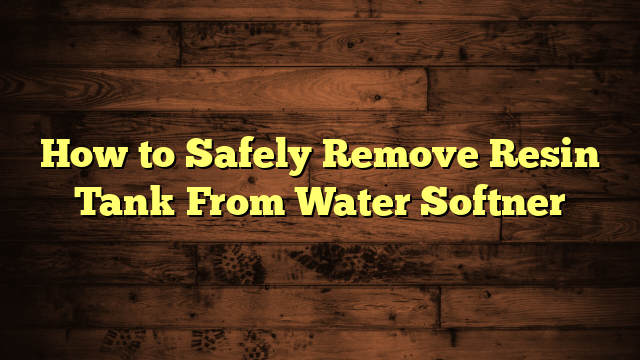How to Safely Remove Resin Tank From Water Softner
You might not realize that removing the resin tank from your water softener is a task that requires both caution and the right approach. Before you proceed, it's vital to understand the necessary steps and tools to avoid damaging your system or causing leaks. There are specific precautions you should take, and knowing them can save you from a lot of headaches down the line. So, what are these essential steps and tools that can guarantee a smooth removal process?
Key Takeaways
- Gather necessary tools like wrenches, screwdrivers, and safety goggles before starting the removal process to ensure safety and efficiency.
- Turn off the water supply by locating and shutting the valve to stop water flow before disconnecting the tank.
- Carefully disconnect the resin tank by loosening inlet/outlet fittings, and gently remove the brine line while having towels ready for spills.
- Inspect the tank and components for any signs of wear, leaks, or damage to ensure proper functionality before reassembly.
- After reassembly, perform a leak check and run a regeneration cycle to confirm the system is functioning correctly.
Gather Necessary Tools
Before you plunge into removing the resin tank from your water softener, you'll need to gather some essential tools.
Start by collecting a pair of adjustable wrenches; these tool types are vital for loosening any fittings or connections. You'll also want to grab a flathead and Phillips screwdriver, as they'll help you access screws that secure the tank in place.
Don't forget to have a bucket or some towels handy to catch any residual water that may spill during the process.
It's also wise to keep a pair of safety goggles nearby; protecting your eyes is a must while working on home appliances. If you have gloves, wear those too—they'll keep your hands clean and safe from sharp edges or debris.
Finally, make sure you have a flashlight or work light, as visibility can be tricky in tight spaces.
Prepare the Work Area
Clearing the area around your water softener is vital for a smooth removal process. Start by removing any items that might obstruct your access to the unit. This includes cleaning supplies, tools, or decorative items that could be in the way. A tidy work area not only makes the task easier but also guarantees you have enough space to maneuver safely.
Next, consider your safety precautions. It's important to wear protective gear like gloves and goggles, as you may encounter spills or sharp edges while working. Make sure your work area is well-lit to avoid any accidents.
If possible, lay down a tarp or old towels to catch any drips from the resin tank, preventing a mess on your floor.
Finally, keep a trash bag handy for any debris. Having a clean and organized work area helps you focus on the task at hand, minimizing distractions and reducing the risk of accidents.
Turn Off the Water Supply
To guarantee a safe removal of the resin tank, you'll need to turn off the water supply to your water softener.
Start by locating the valve shutoff connected to your water softener. This is typically found near the unit itself or along the main water line. It's usually a round or lever-style valve that you can easily turn or pull.
Once you've found the valve, turn it clockwise to shut off the water supply. You should hear a slight noise as the water flow stops.
It's important to verify that all water flow is cut off before proceeding, as any residual pressure could cause spills or leaks when you remove the resin tank.
After shutting off the water supply, it's a good idea to open a nearby faucet to relieve any remaining pressure in the system.
This step will make your task much easier and safer. By taking these precautions, you're setting yourself up for a smooth resin tank removal without any unexpected hiccups.
Disconnect the Resin Tank
Once you've confirmed the water supply is turned off, disconnecting the resin tank is your next step.
First, locate the inlet and outlet connections on the tank. These are typically secured with nuts or clamps. Using a wrench or pliers, carefully loosen the fittings. Make sure you've got a towel handy, as some residual water may escape during this process.
Next, you'll want to disconnect the brine line, which is usually a flexible tube that connects the resin tank to the brine tank. Gently pull it off, making certain you don't damage the fittings. If there's any resistance, check for clamps that might need loosening before removing the line.
For a safe disconnection, always handle the resin tank with care. If you notice any cracks or wear, it's best to stop and assess the situation.
After you've disconnected all necessary lines, double-check that everything is secure and there's no remaining pressure in the system. This attention to detail will help guarantee that the disconnection process goes smoothly, setting you up for success as you prepare to remove the tank completely.
Remove the Tank Carefully
Now that you've disconnected all the necessary lines, it's time to remove the resin tank. Start by putting on your safety gloves and goggles—these safety precautions are vital to protect yourself from any residual resin or chemicals.
Stand close to the tank, ensuring you have a firm grip on it. Utilize proper handling techniques by bending at your knees, keeping your back straight. This posture prevents strain and helps you lift the tank more securely.
As you lift, maintain a steady motion. If the tank feels heavy, don't hesitate to ask for help—two pairs of hands are often better than one. Remember, it's important to keep the tank upright during removal to avoid spillage. If you encounter any resistance, double-check that all connections are fully detached before proceeding.
Once you've successfully lifted the tank, carefully set it down in a safe location, away from any foot traffic. This will help prevent accidents while you work on the next steps of your maintenance.
Inspect the Tank and Components
Once you've removed the resin tank, it's essential to inspect it and its components for any signs of damage.
Start by evaluating the visual condition—look for cracks, discoloration, or wear that could affect performance.
Don't forget to check for leaks, as even a small drip can lead to bigger problems down the line.
Visual Condition Assessment
A thorough visual condition assessment is essential for ensuring your water softener operates efficiently.
Start with a visual inspection of the resin tank and its components. Look for any signs of wear, discoloration, or damage that could affect performance. Pay close attention to the surface analysis of the resin tank; it should be smooth without cracks or abrasions.
Next, examine the inlet and outlet fittings, as well as any associated piping. These areas are vital for maintaining proper water flow. If you notice any corrosion or buildup, it may indicate potential issues that need addressing.
Check the brine tank too, ensuring it's clean and free of debris. A dirty brine tank can hinder the regeneration process, leading to less effective water softening.
As you conduct your visual inspection, take notes on anything that seems out of the ordinary. This documentation will help you or a technician make informed decisions about repairs or replacements.
Check for Leaks
Checking for leaks is essential in maintaining the integrity of your water softener. As you inspect the tank and its components, start with a thorough visual examination. Look for any signs of moisture, corrosion, or cracks around the tank. These could indicate a leak, and if not addressed promptly, you might face significant water damage.
Next, pay close attention to the connections and fittings. Make sure that all hoses, valves, and joints are secure and show no signs of wear. Use leak detection methods, such as applying a few drops of dish soap mixed with water to the connections. If you see bubbles forming, it's a sure sign that there's a leak.
Don't forget to check the brine tank as well. Any leaks here can lead to issues not only with your water softener but also with your home's plumbing.
If you identify a leak, take action immediately. Replacing damaged parts or resealing connections can save you from costly repairs down the line. Keeping your water softener leak-free guarantees peak performance and protects your home from unwanted water damage.
Clean or Replace Resin
When it comes to maintaining your water softener, knowing whether to clean or replace the resin is essential.
You should look for signs of resin damage, like clumping or discoloration, which can indicate it's time for a change.
If the resin is still in good shape, using proper cleaning techniques can help restore its efficiency and extend its lifespan.
Signs of Resin Damage
Often, you'll notice signs of resin damage in your water softener when its performance starts to decline. One key indicator is resin discoloration. If you see that the resin beads have changed color, this could signify that they're no longer effectively softening your water. Look for shades that aren't typical for your system, as this change can affect water quality.
Another sign to keep an eye on is resin clumping. When the beads begin to stick together, they can't function properly, leading to ineffective softening. This clumping often occurs due to excessive hardness minerals or contaminants in the water, and it can severely impact your system's efficiency.
If you observe either resin discoloration or clumping, it's time to assess the condition of your resin. While cleaning might restore some functionality, significant damage may require a complete replacement. Ignoring these signs can lead to further issues, including higher energy costs and poor water quality.
Regular checks and maintenance will guarantee your water softener operates at peak performance, ultimately extending its lifespan and saving you money in the long run.
Proper Cleaning Techniques
To keep your water softener running smoothly, you'll need to clean or replace the resin periodically. The type of resin you have will affect how often you need to perform maintenance. Generally, you should check the resin every six months, but it's wise to adjust based on your water quality and usage.
Here's a handy table to help you determine the best course of action:
| Resin Type | Maintenance Frequency |
|---|---|
| Cation Exchange | Every 6 months |
| Anion Exchange | Every 12 months |
| Mixed Bed Resin | Every 9 months |
When cleaning your resin, start by rinsing it with clean water to remove any debris. If the resin appears discolored or damaged, consider replacing it entirely. You can also use specialized resin cleaners to help rejuvenate the resin's performance.
Reassemble and Test System
After successfully removing the resin tank, it's time to reassemble the water softener and confirm everything's in working order.
Start by carefully placing the resin tank back into its housing. Make sure the inlet and outlet connections align properly, and secure them tightly to avoid leaks.
Next, reconnect the brine line and verify it's snug. Don't skip this step—any loose connections can compromise system functionality.
Once you've reassembled the unit, it's time to test the system. Turn on the water supply and check for any leaks around the connections. If you notice any drips, turn off the water and tighten the fittings.
After confirming there are no leaks, run a regeneration cycle to flush the system. This step helps clear out any remaining debris from your cleaning process.
If the water softener doesn't seem to be functioning properly after reassembly, refer to some troubleshooting tips.
Check the settings on the control panel, and verify the salt levels in the brine tank are adequate. By following these steps, you can confirm your water softener is ready to deliver soft water effectively.
Frequently Asked Questions
How Often Should I Replace the Resin in My Water Softener?
You should replace the resin in your water softener every 10 to 15 years, depending on usage and water quality. Following maintenance tips can help extend resin lifespan, ensuring your system runs efficiently for longer.
Can I Recycle the Old Resin After Removal?
Did you know that recycling resin can reduce landfill waste by over 50%? You can recycle old resin, positively impacting the environment. Check local guidelines to verify proper resin recycling practices in your area.
What Safety Gear Should I Wear During This Process?
When tackling this task, you should prioritize safety precautions. Wear protective equipment like gloves, goggles, and a mask to shield yourself from dust and chemicals. Staying protected guarantees a smoother, safer experience while you work.
How Can I Tell if My Resin Tank Is Damaged?
Inspect your resin tank like a detective searching for clues. Look for cracks, leaks, or discoloration—signs of damage that could spell trouble. Regular resin tank inspections help you catch issues before they escalate. Stay vigilant!
Is It Safe to Remove the Resin Tank Alone?
It's not entirely safe to remove the resin tank alone. For proper resin tank maintenance and to guarantee water softener functionality, consider getting help to prevent damage or personal injury during the process.
Conclusion
By following these steps, you can safely remove the resin tank from your water softener without any hassle. Remember, a well-maintained softener can greatly extend its lifespan and improve your water quality. Curiously, many people underestimate the importance of regular maintenance, believing that water softeners are "set and forget." However, investing a little time in this process can save you from costly repairs down the line. Now, you're equipped to tackle this task confidently!







